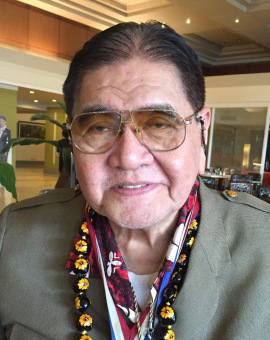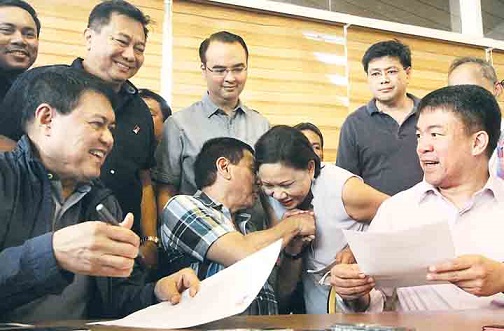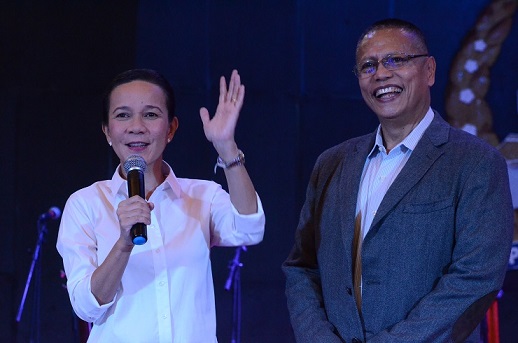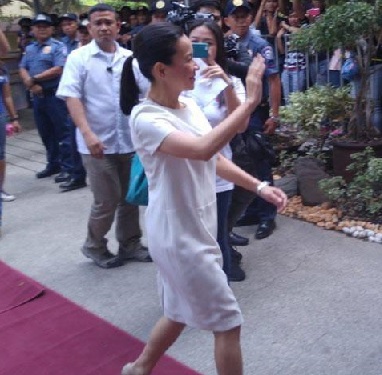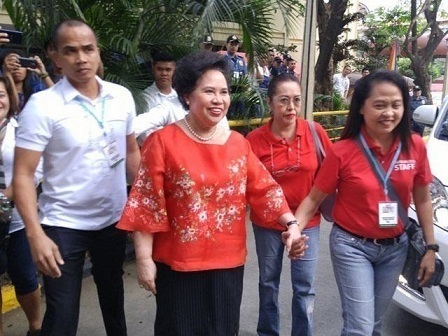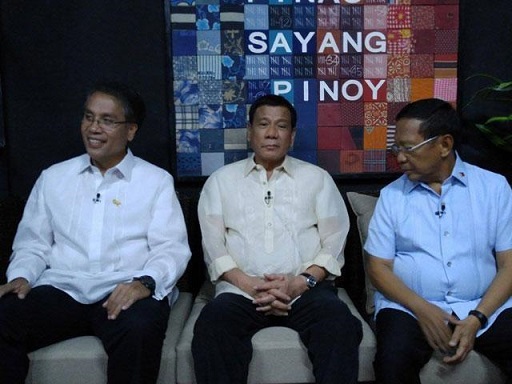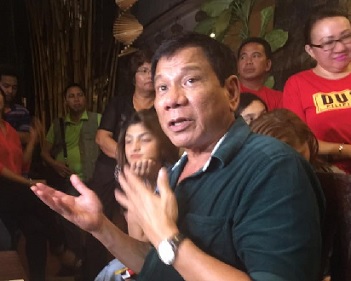
Photo by Dana Batnag
Presumptive President-elect Rodrigo Duterte said early this week he wants to know why the Philippines lost Scarborough Shoal.
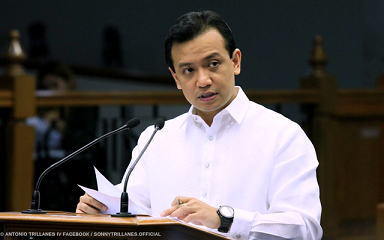
Sen. Antonio Trillanes IV.
When he said this, he was apparently under the impression that Senator Antonio Trillanes IV, who exposed his BPI bank deposits amounting to no less than P200 million despite before the May 9 elections, was responsible for the Philippines losing control over the coral reef formation 124 nautical miles off Zambales.
By all means, Duterte should order a probe.
The term “lost Scarborough shoal” is debatable. Security officials deny that. Foreign affairs officials will not say that because that would be detrimental to the claim of the Philippines on the shoal which is included in the case filed by the Philippines against China before the United National Arbitral Court.
The reality, however, is that Filipino fishermen are denied access to the area around the shoal by three Chinese ships stationed there since June 2012.
How that situation came to be started on April 10, 2012 when BRP Gregorio del Pilar arrested eight Chinese boats with sizable quantities of endangered marine species, corals, live sharks and giant clams.
Chinese fishermen caught in Philippine waters is not an unusual happening – be it in Scarborough shoal or in the Spratlys, in the northwestern part of the country. When that happens, the fishermen are charged in court and the Chinese Embassy works for their release. The case is usually handled in the provincial and regional level.
The use of BRP Gregorio del Pilar, a warship, to arrest Chinese fishing vessels changed the atmosphere in the maritime row.
The rules of engagement in a sea conflict is “white to white, gray to gray.” “White to white” means civilian ships are to deal only with civilian vessels. “Gray to gray” means navy to navy.
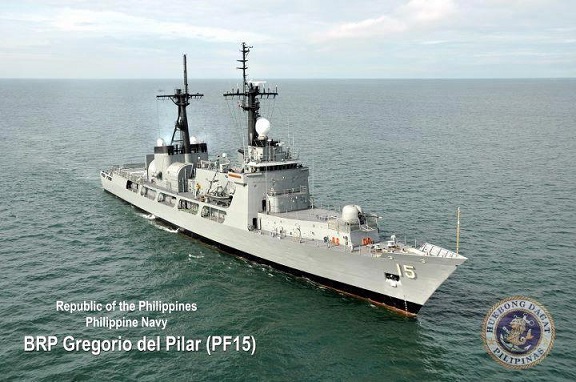
BRP Gregorio del Pilar
ASEAN diplomats say it was a mistake for the Philippines to have sent a warship to confront Chinese fishing vessels. When Aquino was made aware of the mistake, he ordered the withdrawal of BRP Gregorio del Pilar with a face-saving, “As a sign of our goodwill, we replaced our navy cutter with a civilian boat as soon as we could.”
The Chinese did not send a warship against BRP Gregorio del Pilar. Instead they sent at first three Chinese Marine Surveillance (CMS). Then more CMS, fishing boats and dinghies came.
A month after the interception of the fishing vessels, there were 90 Chinese vessels in the Scarborough area – 10 CMS, 30 fishing boats and 50 dinghies – as against the Philippines’ three, yes, a grand total of THREE vessels- two Philippine Coast guard ships and one by the Bureau of Fisheries and Aquatic Resources.
Foreign Secretary Albert del Rosario aggravated the situation when, instead of quiet negotiations, he went to media. He announced he was summoning the Chinese ambassador to file a diplomatic protest. Then he held a press conference with Philippine Navy Chief Alexander Pama and Philippine Coast Guard Commandant Vice Admiral Edmund C. Tan by his side.
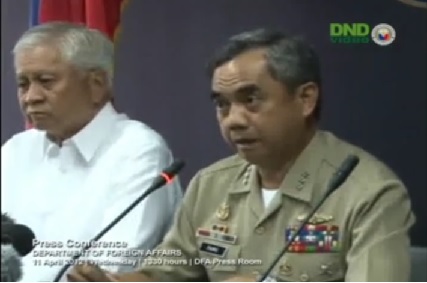
Foreign Secretary Albert del Rosario and Navy Chief Alexander Pama in a press conference.
Diplomatic observers noted that the sight of a foreign secretary with the Navy Chief talking about the arrest of a Chinese fishermen sent a hostile message to the People’s Liberation Army, a potent force in China’s power hierarchy. It was an unnecessary aggravation, something that could have been handled on the department spokesmen level.
Talks in the diplomatic level deteriorated with Del Rosario calling the Chinese ambassador “duplicitous.” Del Rosario ran to Uncle Sam. Beijing, on the other hand, looked for a direct line to Aquino and this was when Trillanes entered the picture using contacts in Beijing which he made during his Nov. 2011 visit.
While Aquino was preparing for a June 8 meeting with President Obama at the White House, the Department of Foreign Affairs was informed that Washington does not want the issue of standoff with China included in the agenda. Malacañang became frantic for the standoff to end.
Both Trillanes and Del Rosario were working for a “simultaneous withdrawal” of vessels in Scarborough shoal but they were not talking with each other. They were both reporting to the President.
It was bizarre kind of negotiation. Del Rosario was talking with Kurt Campbell, U.S. Assistant Secretary of State for East Asian and Pacific Affairs, who was talking with Fu Ying ,vice minister of Foreign Affairs in charge of “Asia, boundary and ocean affairs and translation and interpretation” and fourth in the hierarchy in China’s foreign ministry. She was China’s ambassador to the Philippines from 1998 to 2000.
Trillanes also was talking to Fu Ying and relayed the messages to Aquino back and forth.
The negotiations would require a longer narration of events. But this is a portion of Trillanes report on the back channelling that ended the two-month standoff in Scarborough Shoal:
“For the next 2 weeks (May 2012), confidence building measures were exchanged largely focused on toning down the rhetoric on both sides and arrangements for the withdrawal of ships and the lifting of the travel sanctions on the Chinese tourists…
“The President then directed me to work on the sequential withdrawal of government ships inside the shoal. However, on the morning of 04 June, PNoy called me to inform me that our BFAR vessel has already left the shoal but China has reneged on the agreement of simultaneous withdrawal of ships so 2 CMS vessels are still inside. I asked him, who agreed with what, since I was just hammering out the details of the sequential withdrawal because the mouth of the shoal was too narrow for a simultaneous withdrawal. He told me that Sec. Del Rosario told him about the agreement reached in Washington. This time I asked him, if the agreement was simultaneous withdrawal, why did we leave first? PNoy responded, “kaya nga sinabihan ko si Albert kung bakit nya pinalabas yung BFAR na hindi ko nalalaman.”
“Anyway, PNoy said the situation is grave because he won’t be able to leave for Washington while the 2 CMS vessels are still inside the shoal. I contacted the Beijing negotiators and told them that their ships need to leave the shoal as soon as possible or else PNoy would cancel his trip and we would close the backchannel.
“ Beijing immediately responded and said that 1 CMS vessel would leave at 1700H that same day while the other CMS ship would leave after 48 hrs. They said they needed to do this to project to the Chinese public that they were not pressured into leaving the shoal. I reported this to the President and he had me on speaker phone during an emergency cabinet meeting and (I )advised him to proceed with his scheduled trip at 1300H and if the Chinese reneged on their word, he would be informed while on flight and he can then order his plane to turn around. PNoy agreed with the arrangement and told me that ES Ochoa would be the OIC in relation to the Scarborough Standoff while he is away.
“At 1706H of 04 June, I was informed by Beijing that the CMS vessel has left the shoal. I then informed ES about this and the same was relayed to PNoy. He then told me that he gave explicit instructions to the PCG not to follow any order from Secretary Del Rosario.
“On 06 June, as agreed upon, the other CMS vessel left the shoal.
“Around 10 June, PNoy informed me that the BFAR vessel was ordered to proceed to Subic to undergo repairs and directed me to ask Beijing to reciprocate. I then informed the Beijing negotiators about this and they immediately responded by sending back 2 CMS vessels and 14 fishing boats to China.
“On 15 June, PNoy informed me again that he has ordered the pull-out of the 2 remaining PCG ships from the shoal citing the incoming typhoon as the reason and directed me to ask Beijing to reciprocate. I immediately informed the Beijing negotiators about this development and again, they immediately responded by sending back all the remaining fishing boats and dinghies to China. Only 8 CMS vessels remain at this time.
“Around 02 July, I was able to negotiate for the reduction of the remaining CMS vessels to only 3. At that time, PNoy told me that he would need to decide during the 05 July cabinet meeting whether to proceed with the bilateral/backchannel talks or to internationalize it during the ASEAN Regional Forum on 09 Jul.”
In that July 5 cabinet meeting, Trillanes said,
Del Rosario and Assistant Secretary Henry Bensurto presented the multilateral/internationalize option. … I presented that, contrary to Sec. Del Rosario’s experience, our backchannel negotiations held and proof of it was the drastic reduction of the Chinese vessels from almost a hundred to only 3 with the commitment that they would pull-out the 3 remaining CMS vessels if we won’t raise the dispute during the ARF. Plus, Beijing gave the assurance that they will not put up any structure in or around the shoal. With this, I recommended to PNoy to not internationalize it during the ARF and see if they would live up to their commitment of pulling out completely. If not, I told him, that we could always raise it during the ASEAN Summit in September.”
Del Rosario’s suggestion to internationalize the issue won.
Trillanes further said in his report:
“On 14 July, Sec. Butch Abad asked me if the backchannel is still open. Apparently, we were snubbed by the ASEAN and we’re now stuck with the 3 CMS ships still at the vicinity of the shoal. I asked him if Sec. Del Rosario has a plan B, he said none. I then told him that the precondition for the withdrawal of the 3 ships was that the dispute won’t be raised at the ARF. I then politely declined from continuing with my role as backchannel negotiator since PNoy had already decided his policy action.”
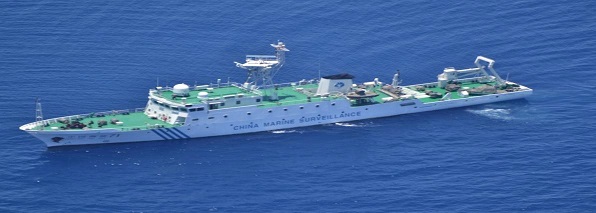
One of the three Chinese Coastguard Maritime Surveillance ships in Scarborough shoal in April 2012
A lot has happened since then. The Philippines went to the Arbitral Court of the United Nations International Tribunal on Law of the Sea in The Hague and asked, among others, that China’s all-all encompassing nine-dash line map be declared illegal. Decision is expected in July.
China’s three ships are still there in Scarborough shoal.
